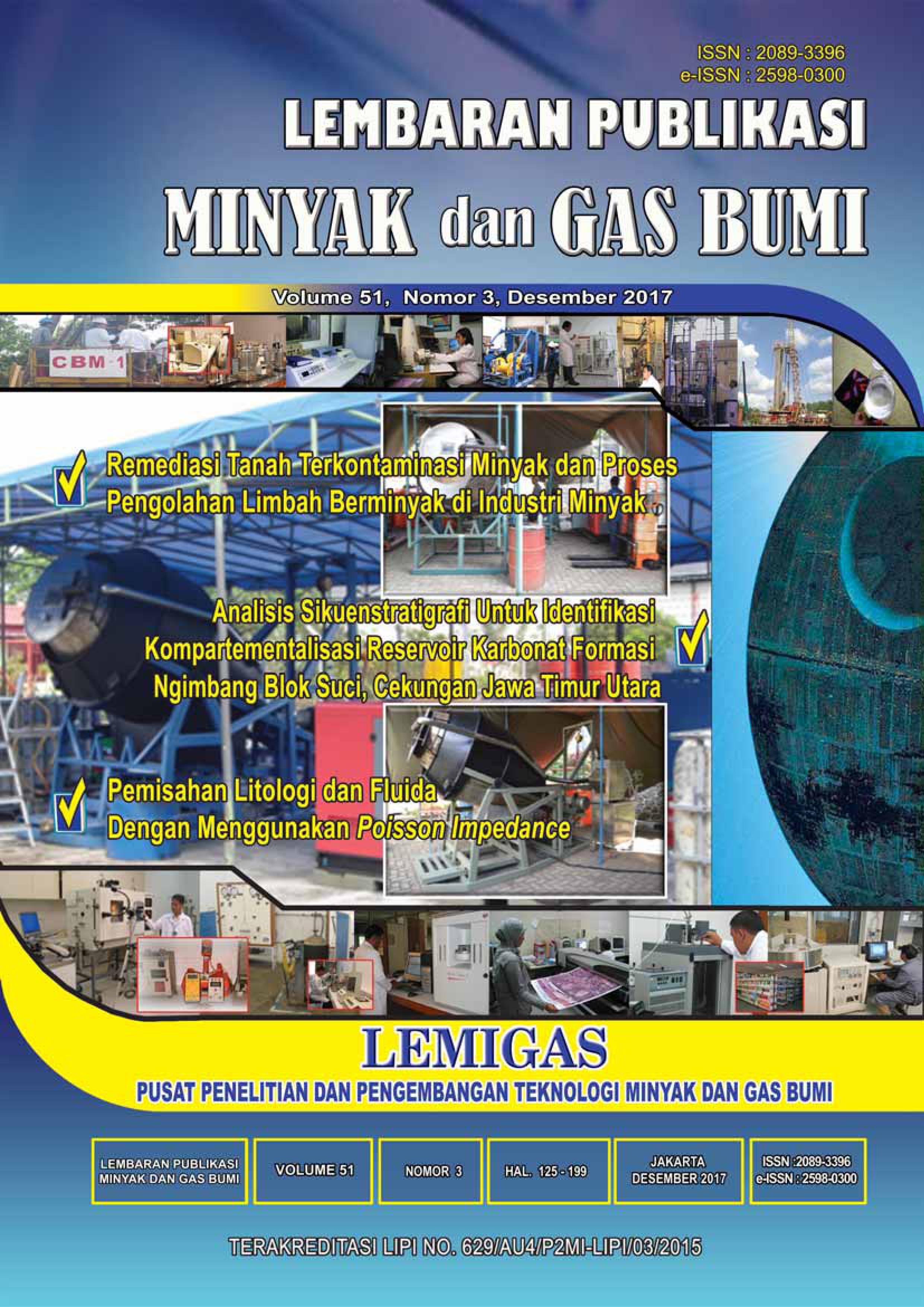REMEDIASI TANAH TERKONTAMINASI MINYAK DAN PROSES PENGOLAHAN LIMBAH BERMINYAK DI LINGKUNGAN INDUSTRI MINYAK (Remediation of Oil Contaminant Soil and Treatment Process of Oily Sludge in the Oil Industry)
DOI:
https://doi.org/10.29017/LPMGB.51.3.27Kata Kunci:
remediasi, TPH, limbahberminyak (remediation, oily waste)Abstrak
Pemulihan tanah terkontaminasi minyak dan pengolahanlimbahberminyak di industri minyak diperlukan oil separation technology yang tepat dan tidak menimbulkan masalah lain. Dalam beberapa kasus, tanah yang terkontaminasi banyak mengandung minyak dan dalam pengelolaannya hanya dikirimkan ke unit pengolahan limbah B-3. Salah satu teknik yang dikembangkan oleh LEMIGAS adalah menggunakan teknik yang terintegritas yaitu menggabungkan pengolahan secara fisika, kimia, dan biologi. Minyak yang masih terdapat dalam tanah dipisahkan dari impuritisnya, seperti tanah, pasir, dan padatan lainnya. Melalui proses pemulihan ini diharapkan minyak yang masih terdapat dalam tanah dapat direduksi sampai batas yang diizinkan oleh peraturan. Di samping itu untuk pengolahan limbah berminyak masih dapat diambil kembali minyaknya sebanyak mungkin (oil recovery). Dari hasil ujicoba skala demo plantunit pada lokasi yang mengandung tanah terkontaminasi, TPH 24,71% dapat direduksi menjadi 0,91%. Selain itu unit tersebut mampu memulihkan limbah berminyak lebih dari 95%.
Remediation of oil contaminated soil and oily wastewater treatment in the oil industry requires proper oil separation technology and does not cause any other problems. In some cases, contaminated soil still contains much oil and in the management is only delivered to the B-3 waste treatment unit. One of the techniques developed by LEMIGAS is to use an integrated technique that combines physical, chemical, and biological processing. Oil still in the soil is separated from the impurities, such as soil, sand, and other solids. Through this recovery process it is expected that the oil still present in the soil can be reduced to the extent permitted by the regulation. In addition to the treatment of oily waste can still be recovered as much oil (oil recovery). From the results of a demonstration scale of demo plant unit on a site containing contaminated soil, TPH 24.71% can be reduced to 0.91%. In addition the unit is able to recover oily waste more than 95%.
Referensi
A. Bhandari, J. T. Novak, D. C. Dove, and V. Tech, 2000, “Effect Of Soil Washing On Petroleum- Hydrocarbon Distribution On Sand Surfaces,” pp. 1–13.
Devgun, J.S., Beskid, N.J., Natsis, M.E., Walker J.S. “Soil Washing as Potential Remediation
Technology for Contaminated Doe Sites.”
E. Koshlaf, E. Shahsavari, A. Aburto-medina, M. Taha, N. Haleyur, T. H. Makadia, P. D.
Morrison, and A. S. Ball, 2016, “Ecotoxicology and Environmental Safety Bioremediation Potential of Diesel-Contaminated Libya Soil,” Ecotoxicol.
Environ. Saf., vol. 133, pp. 297–305.
F. P. De França, 2012, “Waste Management & Research Petroleum Refi neries,” no. July, 2012.
K. Urum, T. Pekdemir, D. Ross, and S. Grigson, 2005, “Crude Oil Contaminated Soil Washing InAir Sparging Assisted Stirred Tank Reactor Using Biosurfactants,” vol. 60, pp. 334–343.
M. E. R. Gutierrez and E. R. Bandala, 2017, Industry Effl uents, no. 1. Elsevier B.V.
N. Karthika, K. Jananee, and V. Murugaiyan, 2016, “Remediation of Contaminated Soil Using Soil Washing-a review,” vol. 6, no. 1, pp. 13–18.
S. Gan, E. V Lau, and H. K. Ng, 2009, “Remediation Of Soils Contaminated With Polycyclic Aromatic Hydrocarbons ( PAHs ),” vol. 172, pp. 532–549.
“Survey of Technology for Remediation of Oil- Contaminated Soil in Kuwait,”, 1999, pp. 1–15.
U. E. Ezeji, S. O. Anyadoh, and V. I. Ibekwe, 2007, “Clean up of Crude Oil-Contaminated Soil”.
Zulkifl iani, “Penanggulangan Tanah Terkontaminasi Oleh Limbah Minyak Dari Kilang/Unit Pengolahan Dengan Bios Oil Removal Pada Skala Laboratorium (Tahap-I),” LEMBARAN PUBLIKASI LEMIGAS vol. 038, no. 3, 2004.
Zulkifliani, 2011,“Penanggulangan Tanah Terkontaminasi Limbah Minyak Menggunakan Teknik Bios (Skala Pilot),” LEMBARAN PUBLIKASI LEMIGAS vol. 045, no. 1, pp. 11-16.











